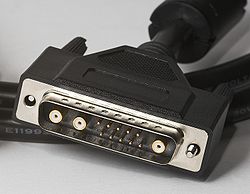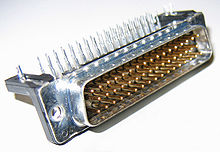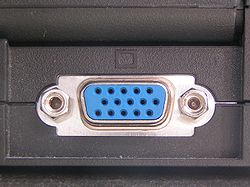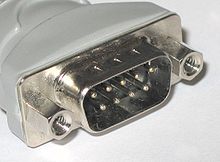- D-subminiature
-
The D-subminiature or D-sub is a common type of electrical connector. They are named for their characteristic D-shaped metal shield. When they were introduced, D-subs were among the smaller connectors used on computer systems.[citation needed]
Contents
Description, nomenclature, and variants
 Male 13W3 Plug
Male 13W3 Plug
A D-sub contains two or more parallel rows of pins or sockets usually surrounded by a D-shaped metal shield that provides mechanical support, ensures correct orientation, and may screen against electromagnetic interference. The part containing pin contacts is called the male connector or plug, while that containing socket contacts is called the female connector or socket. The socket's shield fits tightly inside the plug's shield. The plug also may have screws on either side of the shield that fasten into holes in the socket (although sometimes the screws are on the socket: see the DE9 pictured to the left). When screened cables are used, the shields are connected to the overall screens of the cables. This creates an electrically continuous screen covering the whole cable and connector system.
The D-sub series of connectors was invented by ITT Cannon, part of ITT Corporation, in 1952.[1] Cannon's part-numbering system uses D as the prefix for the whole series, followed by one of A, B, C, D, or E denoting the shell size, followed by the number of pins or sockets, followed by either P (plug) or S (socket) denoting the gender of the part. Each shell size usually (see below for exceptions) corresponds to a certain number of pins or sockets: A with 15, B with 25, C with 37, D with 50, and E with 9.[2] For example, DB25 denotes a D-sub with a 25-position shell size and a 25-position contact configuration. The contacts in either row of these connectors are spaced 326/3000 of an inch apart, or approximately 0.109 inches (2.77 mm), and the rows are spaced 0.112 inches (2.84 mm) apart (the pins in the two rows are offset by half the distance between adjacent contacts in a row).[3] The suffixes M and F (for male and female) are sometimes used instead of the original P and S.
This naming pattern is not always followed, however. Because personal computers first used DB25 connectors for their serial and parallel ports, when the PC serial port began to use 9-pin connectors, they were often labeled as DB9 instead of DE9 connectors, due to an ignorance of the fact that B represented a shell size. It is now common to see DE9 connectors sold as DB9 connectors. DB9 nearly always refers to a 9-pin connector with an E size shell. The non-standard 23-pin D-sub connectors for external floppy drives and video output on most of the Amiga computers are usually labeled DB23, even though their shell size is two pins smaller than ordinary DB sockets.
There are now D-sub connectors which have the original shell sizes, but more pins, and their names follow the same pattern. For example, the DE15, usually found in VGA cables, has 15 pins in three rows, all surrounded by an E size shell. The pins are spaced at 0.090 inches (2.3 mm) horizontally and 0.078 inches (2.0 mm) vertically.[3]) The other connectors with the same pin spacing are the DE15, DA26, DB44, DC62, and DD78. Reflecting the same confusion of the letters DB with just D as mentioned above, these connectors are also often called DB15HD (or even DB15 or HD15), DB26HD, DB44HD, DB62HD, and DB78HD connectors, respectively, where HD stands for "high density". They all have three rows of pins, except the DD78, which has four. The "double density" series of D-sub connectors features even denser arrangements and consists of the DE19, DA31, DB52, DC79, and DD100. These each have four rows of pins.
Cannon also produced "hybrid" D-subs with larger contacts in place of some of the normal contacts that could be used for high-current, high-voltage, or co-axial inserts. The DB13W3 variant was commonly used for high-performance video connections; this variant provided 10 regular (#20) pins plus three coaxial contacts for the red, green, and blue video signals. Hybrid D-subs are currently being manufactured in a broad range of configurations by other companies, including Amphenol, Conec, Teledyne Reynolds, Assmann Electronics, Norcomp, Cinch, 3M, and Tyco. Some variants have current ratings up to 40A or operating voltages as high as 13,500V; others are waterproof and meet IP67 standards.
A smaller type of connector derived from the D-sub is called the microminiature D, or micro-D, which is a trademark of ITT Cannon. It is about half the length of a D-sub.
There is yet another similar family of connectors that is easy to confuse with the D-sub family. These connectors have names like HD50 and HD68, and have a D-shaped shell that is about half the width of a DB25. They are common in SCSI attachments.
The original D-sub connectors are now defined by an international standard, IEC 60807-3 / DIN 41652. The United States military also maintains another specification for D-subminiature connectors, the MIL-DTL-24308 standard.[3]
Typical applications
 D-sub connectors.
D-sub connectors.
The connector on the left is a 9-pin male (DE9M) connector plug, and the one on the right is a 25-pin female (DB25F) socket. The hexagonal pillars (4-40 bolt) at either end of each connector have a threaded stud (not visible) that passes through flanges on the connector, fastening it to the metal panel. They also have a threaded hole that receives the jackscrews on the cable shell, to hold the plug and socket together.Communications ports
The widest application of D-subs is for RS-232 serial communications, though the standard did not make this connector mandatory. RS-232 devices originally used the DB25, but for many applications the less common signals were omitted, allowing a DE9 to be used. The standard specifies a male connector for terminal equipment and a female connector for modems, but many variations exist. IBM PC-compatible computers tend to have male connectors at the device and female connectors at the modems. Early Apple Macintosh models used DE9 connectors for RS-422 serial interfaces (which can operate as RS-232). Later Macintosh models use 8-pin miniature DIN connectors instead.
On PCs, 25-pin and (beginning with the IBM-PC/AT) 9-pin plugs are used for the RS-232 serial ports; 25-pin sockets are used for the parallel printer ports (instead of the Centronics socket found on the printer itself).
Many uninterruptible power supply units have a DE9F connector on them in order to signal to the attached computer via an RS-232 interface. Often these do not send data serially to the computer but instead use the handshaking control lines to indicate low battery, power failure, or other conditions. Such usage is not standardized between manufacturers and may require special cables.
Network ports
DE9 connectors were used for some token ring networks as well as other computer networks.
The Attachment Unit Interfaces that were used with 10BASE5 "thick net" in the 1980s and 1990s used DA15 connectors for connectivity between the Medium Attachment Units and (Ethernet) network interface cards, albeit with a sliding latch to lock the connectors together instead of the usual hex studs with threaded holes. (The sliding latch was intended to be quicker to engage and disengage and to work in places where jack screws could not be used for reasons of component shape.
Computer video output
A female 9-pin connector on an IBM compatible personal computer may be a video display output such as MDA, Hercules, CGA, or EGA (rarely VGA or others). Even though these all use the same DE9 connector, the displays cannot all be interchanged and monitors or video interfaces may even be damaged if connected to an incompatible device using the same connector.
Later analog video (VGA and later) adapters generally replaced these connectors with DE15 high-density sockets (though some early VGA devices still used DE9 connectors). DE15 connectors are similar to DE9 connectors (see above).
Many Apple Macintosh models (beginning with the Macintosh II) used DA15 sockets for analogue RGB video out. Just prior to this, the Apple IIgs used the same connector for the same purpose, but in a non-compatible way. A digital (and thus also incompatible) RGB adapter for the Apple IIe also used a DA15F. And the Apple IIc used a DA15F for an auxiliary video port which was not RGB, but provided the necessary signals to derive RGB.
Game controller ports
Starting in the late 1970s the Atari 2600 game console used DE9 connectors without the pair of fastening screws (male on the system, female on the controller) for its game controller connectors. In the years following, various video game consoles and home computers adopted the connector for their own game ports, though they were not all interoperable. The common wirings supported digital connections for up, down, left, and right buttons along with one or two others. Some systems supported connecting a pair of analog potentiometers, or paddles, and on some computers a computer mouse or a light pen was also supported via the game port. Like joysticks, these devices were not typically interchangeable between different systems.
Systems utilizing the DE9 connector for their game port included the Atari 8-bit and ST lines; the Commodore VIC-20, 64, 128, and Amiga; the Amstrad CPC (which employed daisy-chaining when connecting two Amstrad-specific joysticks); the MSX, Sharp X68000, and FM-Towns, predominantly used in Japan; the Sega Master System and Sega Genesis; and the Panasonic 3DO. The Sinclair ZX Spectrum lacked a built-in joystick connector of any kind but aftermarket interfaces provided the ability to connect DE9 joysticks.
Many Apple II computers also used DE9 connectors for joysticks, but they had a female port on the computer and a male on the controller, used analog rather than digital sticks, and the pin-out was completely unlike that used on the aforementioned systems. DE9 connectors were not used for game ports on the Apple Macintosh, Apple III, IBM PC systems, or most newer game consoles.
DA15S connectors are used for PC joystick connectors, where each DA15 connector supports two joysticks each with two analog axes and two buttons. In other words, one DA15S "game adapter" connector has 4 analog potentiometer inputs and 4 digital switch inputs. This interface is strictly input-only, though it does provide +5V DC power. Some joysticks with more than two axes and/or more than two buttons use the signals designated for both joysticks. Conversely, Y-adapter cables are available that allow two separate joysticks to be connected to a single DA15 game adapter port; if a joystick connected to one of these Y-adapters has more than two axes or buttons, only the first two of each will work.
The IBM DA15 PC game connector has been modified to add a (usually MPU-401 compatible) MIDI interface, and this is often implemented in the game connectors on third-party sound cards, for example the Sound Blaster line from Creative Labs. The "standard" straight game adapter connector (introduced by IBM) has three ground pins and four +5V power pins, and the MIDI adaptation replaces one of the grounds and one of the +5V pins, both on the bottom row of pins, with MIDI In and MIDI Out signal pins. (There is no MIDI Thru provided.) Creative Labs introduced this adaptation.[citation needed]
Other
25-pin sockets on Macintosh computers are typically SCSI connectors (again in contrast to the Centronics C50 connector typically found on the peripheral), while older Sun hardware uses DD50 connectors for FastSCSI equipment.
The complete range of D-sub connectors also includes DA15s (one row of 7 and one of 8), DC37s (one row of 18 and one of 19), and DD50s (two rows of 17 and one of 16); these are often used in industrial products, the 15-way version being commonly used on rotary and linear encoders.
The early Macintosh and late Apple II computers used an obscure 19-pin D-sub for connecting to external floppy disk drives. The Commodore Amiga used an equally unusual 23-pin version for both its video output and connection to an external floppy disk drive.
TASCAM used DB25 connectors for their multi-track recording audio equipment (TDIF), and Logitek Audio later did the same for its broadcast consoles, though with different pinouts.[4] Roland used DB25 connectors for their multi-track recording audio equipment (R-BUS). A few patch panels have been made which have the DB25 connectors on the back with phone jacks (or even TRS jacks) on the front, however these are normally wired for TASCAM, which is more common outside of broadcasting.
In broadcast and professional video, "parallel digital" is a digital video interface that uses DB25 connectors, per the SMPTE 274M specification adopted in the late 1990s. The more common SMPTE 259M "serial digital interface" (SDI) uses BNC connectors for digital video signal transfer.
Wire-contact attachment types
 A male PCB-mounting DD50 connector
A male PCB-mounting DD50 connector
There are at least five different methods used to attach wires to the contacts in D-sub connectors.
- Solder-bucket (or solder-cup) contacts have a cavity into which the stripped wire is inserted and hand-soldered.
- Insulation displacement contacts (IDCs) allow a ribbon cable to be forced onto sharp tines on the back of the contacts; this action pierces the insulation of all the wires simultaneously. This is a very quick means of assembly whether done by hand or automatically.
- Crimp contacts are assembled by inserting a stripped wire end into a cavity in the rear of the contact, then crushing the cavity using a crimp tool, causing the cavity to grip the wire tightly at many points. The crimped contact is then inserted into the connector where it locks into place. Individual crimped pins can be removed later by inserting a special tool into the rear of the connector.
- PCB pins are soldered directly to a printed circuit board and not to a wire. These connectors are frequently mounted at a right angle to the PCB, allowing a cable to be plugged into the edge of the PCB assembly.
- Wire wrap connections are made by wrapping solid wire around a square post with a wire wrap tool. This type of connection is usually used in prototyping.
Usage
The 25-pin D-sub connector is occasionally used in recording studios for multi-channel analog audio and AES digital audio.
The D-sub connector family is now in decline for general usage in the computer industry, due to size and cost. For portable devices such as PDAs, MP3 players or mobile phones, the D-sub connector is usually too large to fit. In the laptop computer sector, where weight and size are crucial, many models no longer include D-subs. Even small form factor desktop PCs may find D-sub connectors too large for their value.
Because of its relative complexity (the D-shaped metal shield, the screws and nuts), D-sub connectors are now quite expensive compared to other, mostly simpler, common connectors. In the retail PC world where margins are very thin, these connectors are a natural target for removal.
The physical design of D-sub connectors is ill-suited for consumer plug-and-play applications. Thin metal pins, especially in higher-density connectors, are easily bent or broken, particularly if frequently plugged in by touch behind equipment. The need to tighten screws for a secure connection is cumbersome. Although ESD- and EMI-resistant D-sub connectors exist, the fundamental design was never intended to protect from electrostatic discharge or electromagnetic interference or facilitate very high frequency interconnections.[citation needed]
For video purposes, the DE15HD connector is in the process of being replaced by DVI and HDMI connectors. A notable exception to this replacement is on the many analog CRT monitors still in use: the analog version of the DVI connector is similar in price and more complex than the D-sub, so the shift away from D-subs is slow in this case. For the majority of other consumer applications, D-sub serial and parallel connectors have been replaced by the physically much simpler and cheaper IEEE 1394 (FireWire), SATA, USB, or modular connectors.
See also
References
- ^ Are D Subs from all manufactures compatible? — reply in the FAQ section of the Cannon company web
- ^ ITT Cannon 90° PCB Selection Guide, accessed at RS Components website on 2007-09-10
- ^ a b c "List Mil Specs - DSCC". Dscc.dla.mil. http://www.dscc.dla.mil/Programs/MilSpec/ListDocs.asp?BasicDoc=MIL-DTL-24308. Retrieved 2010-08-18.
- ^ "DTRS - Analog DB25 Pin-out" (PDF). http://tascam.com/content/downloads/products/305/TECH_DB25_Pinout.pdf. Retrieved 2010-08-18.
External links
- Comprehensive DB25 wiring diagrams: Tascam, Apple, SCSI, etc..
- Ishmael Stefanov-Wagner's web page on D-Subminiature Nomenclature[dead link]
- A list of common computer connectors, including most D-sub
- Devices with DE-9 connectors
- DE-9 Connector RS-232 Pinout
Audio and video connectors Single conductor audio Analog audio Digital audio Video Audio and Video Visual charts Audio and Video Interfaces and Connectors Audio Only AnalogInterface: PC System Design Guide Connectors: TRS 3.5mmDigitalVideo Only AnalogDigital and
AnalogVideo and Audio DigitalInterface: HDMI Connectors: HDMI connector • Interface: DisplayPort Connectors: DisplayPort connectorRF connectors (coaxial) APC-7 · BNC · C · F · FME · Hirose U.FL · IPX · Motorola · MCX · MMCX · N · QLS · QMA/QN · RCA · SMA · SMB · SMC · Twin-lead · TNC · TV aerial plug · UHF / Mini-UHF
Variations and alternate names: 2.9 mm (SMA) · 7 mm · Triax / Triaxial · Twin BNC / Twinax (BNC) · IPEX · MHF · AMC (UFL) · SnapN · RP-TNC · RP-SMA
Old or seldom used: EIA · GR · LEMO 00 · MusaSee also: Radio frequency · Radio spectrum · Audio and video connectors · Audio and video interfaces and connectorsCategories:- Electrical signal connectors
- Audiovisual connectors
Wikimedia Foundation. 2010.





